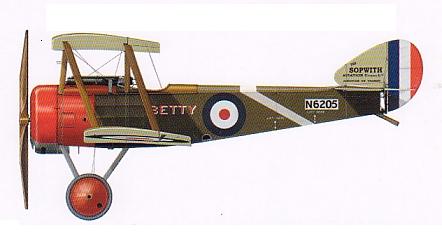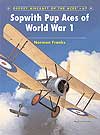S u m m a r y
|
| Publisher and
Catalogue Details: |
Osprey Aircraft of the
Aces #67 “Sopwith Pup Aces of World War 1” |
| ISBN: |
1841768863 |
| Media and
Contents: |
Soft cover, 96 pages |
| Price: |
GB£12.99 online from Osprey Publishing |
| Review Type: |
FirstRead |
| Advantages: |
Well researched, easy
to read style, excellent use of first hand accounts and
superb colour profiles. |
| Disadvantages: |
|
|
Recommendation: |
Highly Recommended
|
Reviewed by
Rob Baumgartner

Osprey's
Sopwith Pup Aces of World War 1
may be ordered online from Squadron.com
The Sopwith Pup has been much forgotten when it comes to the subject
of Aces. Usually these airmen are related to the more popular later
aircraft of World War 1.
It is quite surprising how many pilots did score 5 or more victories in
a “Pup”, the design being renowned for its docile, forgiving
characteristics.
Norman Franks has brought this to the attention of the wider public with
this latest release from Osprey.
There are more than 90 black and white photographs contained in the 96
pages common to this series. Each is printed as clear as the source
material will allow and there are many images that will be new to a lot
of Pup fans.
The book starts with a description of the aircraft and includes the
reminiscences of the type by William Mays Fry MC. His account of the one
he flew with a Gnôme rotary engine is very enlightening.
The first Pup victory with the prototype aircraft starts a narrative
which covers the type’s claims from the first RFC Pup Unit to the start
of “Bloody April”. The latter is the domain of chapter two and goes on
to describe the actions that took place during one of the worst periods
of the war for the British flyers.
Chapter three continues on after this bleak episode and follows the
Pup’s fortunes to the point where other more advanced aircraft are
starting to take to the skies. The final instalment takes the reader
from late July 1917 until the final Pup victory on the 1 December 1917
by Eric Hughes of No. 46 Sqn.
Harry Dempsey provides the artwork and this assortment is up to his
usual very high standards. Sixteen colour plates adorn the pages and
these are supplemented by four additional plan views. The captions
accompanying the aircraft are very detailed show the depth to which the
author has done his research.

The appendices hold much information, the first piece being an article
by Flt. Lt C R Mackenzie of 8 Naval Squadron. His notes on “Aerial
Fighting in Formation” are very interesting reading. Here he describes
the actions to be taken by an 80 hp Le Rhone Sopwith Scout (Pup) in a
variety of situations, both in attack, defence and formation flying.
Next is a list of Pup Aces. I’m sure many will be surprised that at
least 29 pilots scored 5 or more victories in the type. The author lists
these men as well as their ultimate total.
There is also a breakdown of the individual claims by these airmen
including the enemy aircraft type, location, time, and serial number of
the Pup used when known.
A list of “successful” Pup airframes follows with twenty four different
aircraft having been involved in five or more victories.
A set of 1/48 scale general arrangement drawings complete the book.
Norman Franks has done a fine job of bringing to light an often
forgotten mount of the Aces of World War 1. The easy to read nature of
the text and the liberal use of first hand accounts make this a pleasing
addition to an outstanding series.
Highly Recommended
Sopwith Pup Aces of World War 1
(Aircraft of
the Aces 67) |

|
| |
 |
Author:
Norman Franks
Illustrator: Harry Dempsey
US Price: $19.95
UK Price: £12.99
Publisher:
Osprey Publishing
Publish Date: July 15, 2005
Details: 96 pages; ISBN:
1841768863 |
|
|
Review Copyright © 2004 by
Rob Baumgartner
Page Created 12 July, 2005
Last updated 12 July, 2005
Back to
HyperScale Main Page
Home | What's
New | Features
| Gallery |
Reviews | Reference
| Forum
| Search